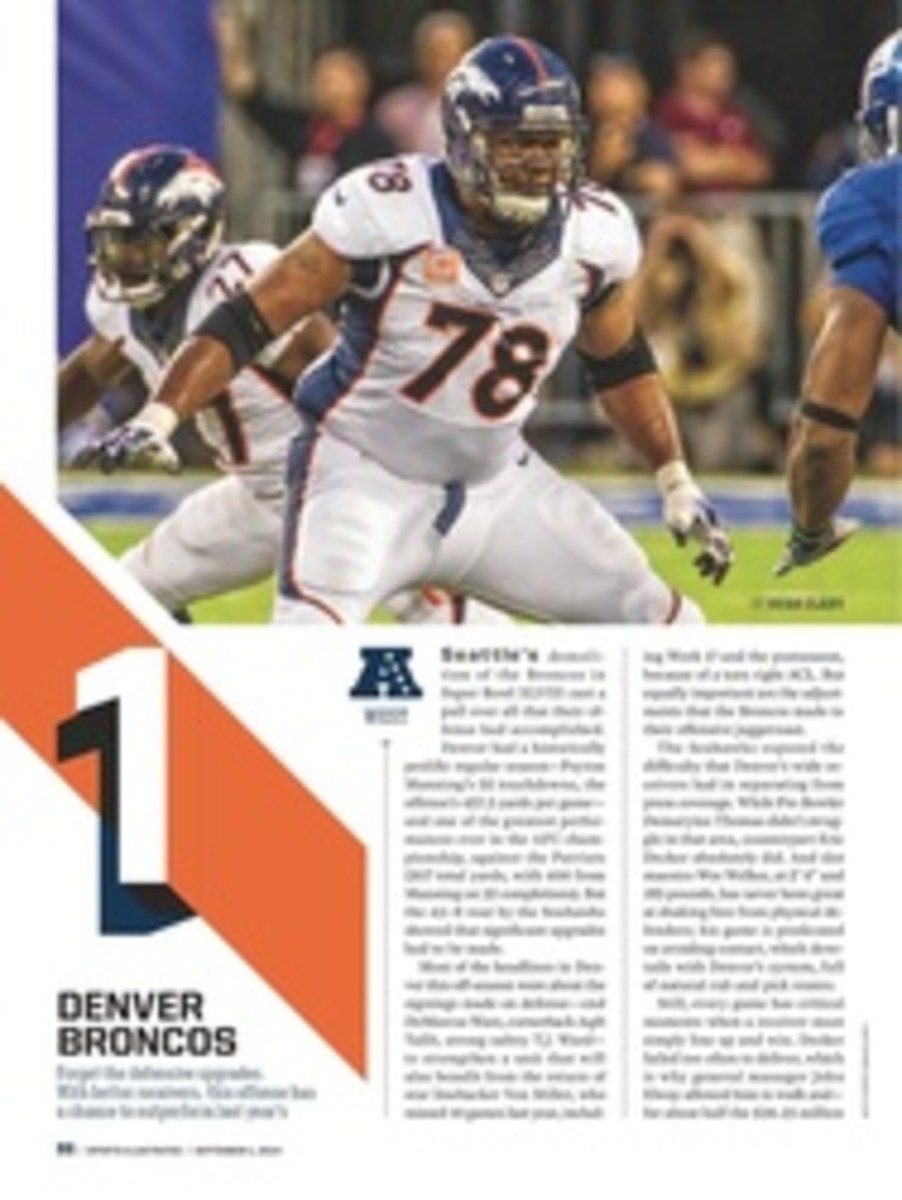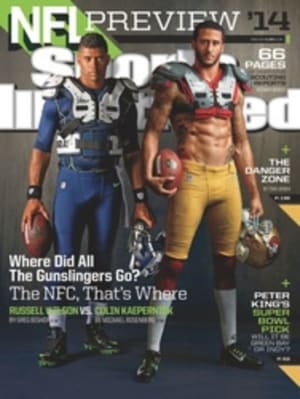
1 DENVER BRONCOS
Seattle's demolition of the Broncos in Super Bowl XLVIII cast a pall over all that their offense had accomplished. Denver had a historically prolific regular season—Peyton Manning's 55 touchdowns, the offense's 457.3 yards per game—and one of the greatest performances ever in the AFC championship, against the Patriots (507 total yards, with 400 from Manning on 32 completions). But the 43--8 rout by the Seahawks showed that significant upgrades had to be made.
Most of the headlines in Denver this off-season were about the signings made on defense—end DeMarcus Ware, cornerback Aqib Talib, strong safety T.J. Ward—to strengthen a unit that will also benefit from the return of star linebacker Von Miller, who missed 10 games last year, including Week 17 and the postseason, because of a torn right ACL. But equally important are the adjustments that the Broncos made to their offensive juggernaut.
The Seahawks exposed the difficulty that Denver's wide receivers had in separating from press coverage. While Pro Bowler Demaryius Thomas didn't struggle in that area, counterpart Eric Decker absolutely did. And slot maestro Wes Welker, at 5'9" and 185 pounds, has never been great at shaking free from physical defenders; his game is predicated on avoiding contact, which dovetails with Denver's system, full of natural rub and pick routes.
Still, every game has critical moments when a receiver must simply line up and win. Decker failed too often to deliver, which is why general manager John Elway allowed him to walk and—for about half the $36.25 million that Decker cost the Jets—signed Emmanuel Sanders. At 5'11" and 180 pounds, the former Steeler can't necessarily shed a corner's physical jam either, but he has the multidirectional quickness to evade it. With Manning, Sanders will be a star. The Broncos also invested a second-round pick in Cody Latimer out of Indiana, who will have the luxury of learning as a reserve early in his career.
While Manning's Colts were known for their static formations and rote but well-practiced play designs, these Broncos are noted for their array of different packages. Their three-receiver base package aligns players in all different spots. Julius Thomas, a fourth-year pro but only second-year contributor, is the catalyst for this. At 6'5" and 250 pounds and possessing solid speed plus great body control, Thomas is the toughest athletic matchup at his position beside Jimmy Graham.
Last season offensive coordinator Adam Gase designed shrewd plays that had Thomas lined up by himself on the weak side of Denver's staple 3 √ó 1 sets, which put all three wideouts on the same side as a way of confounding zone principles or creating favorable matchups against man-to-man. Gase plans on featuring Thomas even more this season, with 3 √ó 1 being just one element of the equation.
Up front the line has been reconfigured. Right tackle Orlando Franklin had problems with nearly everyone who lined up across from him last season, but now that Pro Bowl left tackle Ryan Clady is back from a left Lisfranc injury, replacement Chris Clark can shift to right tackle, where he'll warm the seat for the prospective long-term solution, third-round rookie Michael Schofield. Franklin, meanwhile, will move inside and take a shot at replacing departed left guard Zane Beadles.
These changes may not rectify all the O-line weaknesses, but the Broncos don't need perfection there. Manning, with his pocket mobility and quick decision-making, merely requires an offensive line that won't self-destruct.
Manning's most overlooked attribute is his savvy in audibling into running plays. If he sees two high safeties—which happens often, given defenses' reluctance to blitz him—he'll check to a run that gives his back a blocking advantage. This year that back will be 2013 second-rounder Montee Ball, taking the place of the more well-rounded but less dynamic Knowshon Moreno, who was not re-signed and joined Miami.
The Broncos wouldn't turn to Ball if they didn't believe he would improve in the passing game. Blitz pickup is a learning process for most young backs, and with Manning's predilection for making use of all eligible targets, Ball will have to excel as a short-yardage receiver as well. After all, he's playing in an offense that was the most prolific ever, and now must be even better.
2014 SCHEDULE
2013 Record: 13--3
WEEK 1
IND [HOME]
KC [HOME]
SEA [AWAY]
BYE
ARI [HOME]
NYJ [AWAY]
SF [HOME]
SD THUR [HOME]
NE [AWAY]
OAK [AWAY]
STL [AWAY]
MIA [HOME]
KC [AWAY]
BUF [HOME]
SD [AWAY]
CIN MON [AWAY]
OAK [HOME]
WEEK 17
FOCUS ON
Stopping the run
While injuries led to instability down the stretch last year for Denver's pass coverage, its run defense was stellar, even though the front seven was also dealing with serious losses. In addition to missing sturdy edge-setter and backside chaser Von Miller, there were injuries to high-octane lineman Derek Wolfe (spinal cord) and gap-shooting tackle Kevin Vickerson (dislocated right hip). Still, over their final five games (including postseason), the Broncos yielded an average of just 83.0 yards on the ground. The biggest reason was Terrance (Pot Roast) Knighton. The beefy 6'3", 335-pound nosetackle has remarkably light feet and can burst off blocks because of the favorable positioning he achieves with his quick first step. Another reason was Sylvester Williams, a 2013 first-round rookie tackle who improved as the season went on. With the rest of the front mostly healthy again, Williams and the 28-year-old Knighton (who is playing for a new contract) are primed for even better performances.
THE CASE FOR
Strong safety T.J. Ward
The defense this year will feature the return of outside linebacker Von Miller from injury and the arrival of future Hall of Fame pass rusher DeMarcus Ware from Dallas. Also, the Broncos added former Patriots corner Aqib Talib, a 2013 Pro Bowler who excels in the man coverage that coach John Fox and defensive coordinator Jack Del Rio have used regularly over the past two years. While Miller's return is significant, the two big-name free agents may not make as huge a difference as expected. Sure, both can be great, but Ware is replacing the reliable Shaun Phillips, while Talib succeeds Dominique Rodgers-Cromartie, whom quarterbacks barely even threw at last season. The unit's most significant upgrade is likely to be Ward, who takes over a position that has been a revolving door in Denver for some time. The former Brown has always been a bone-rattling tackler, but where his value has really skyrocketed is in coverage. A borderline liability there early in his career, the 27-year-old Ward can now handle tight ends man-to-man, giving Fox and Del Rio flexibility with the rest of their coverages.
PHOTO
CHRISTOPHER SZAGOLA/CSM
OT RYAN CLADY
PHOTO
DOUG PENSINGER/GETTY IMAGES
NINTEEN PHOTOS

